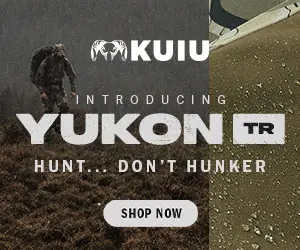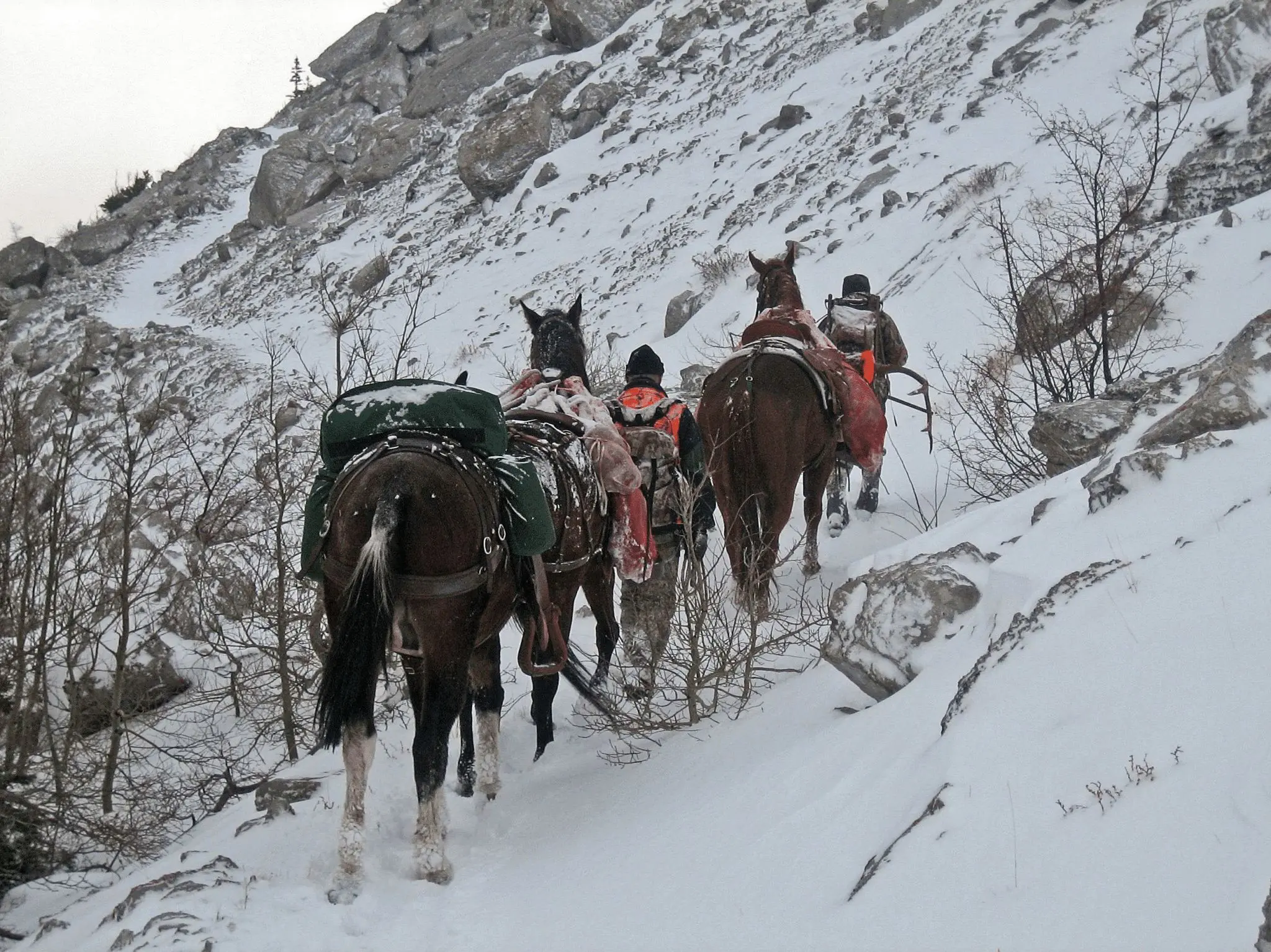
NOTICE: Certain links on this post may earn a commission for Western Hunter Magazine from Amazon or our other affiliate partners when you make a purchase. Thank you for your support.
Managing Snow, Ice, and Wind on a Horseback Hunt
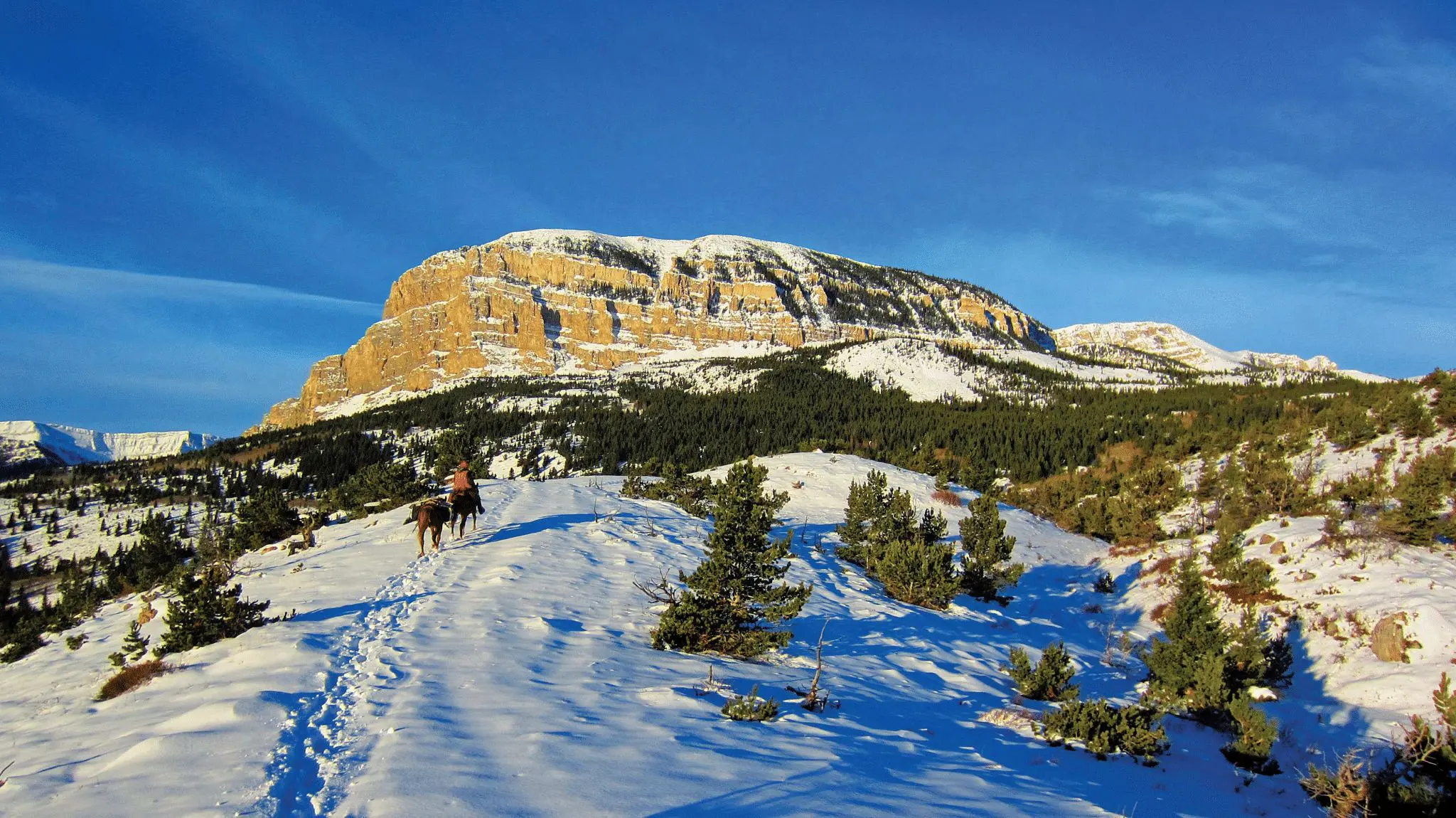
Montana’s big game seasons have run through the weekend following Thanksgiving almost “since time began” and offer the hunting horseman all of the benefits related to the weather that brings big game animals out of the backcountry as well as the challenges that accompany late November weather in the Rocky Mountains. I have made annual late season hunts throughout Montana since the early 1970’s and during that time I have experienced just about everything Mother Nature has to offer at this time of the year. Although I have hunted many different mountain ranges, the Rocky Mountain Front Range offers the most significant challenges, however all of the mountain ranges east of the Continental Divide offer similar challenges.
Snow
It is not unusual for the backcountry hunter to encounter snow throughout the west during the fall of the year. In most cases snow is greeted enthusiastically by the hunter as it usually improves hunting conditions and causes big game movements that enhance the hunters’ opportunity to harvest the game they seek.
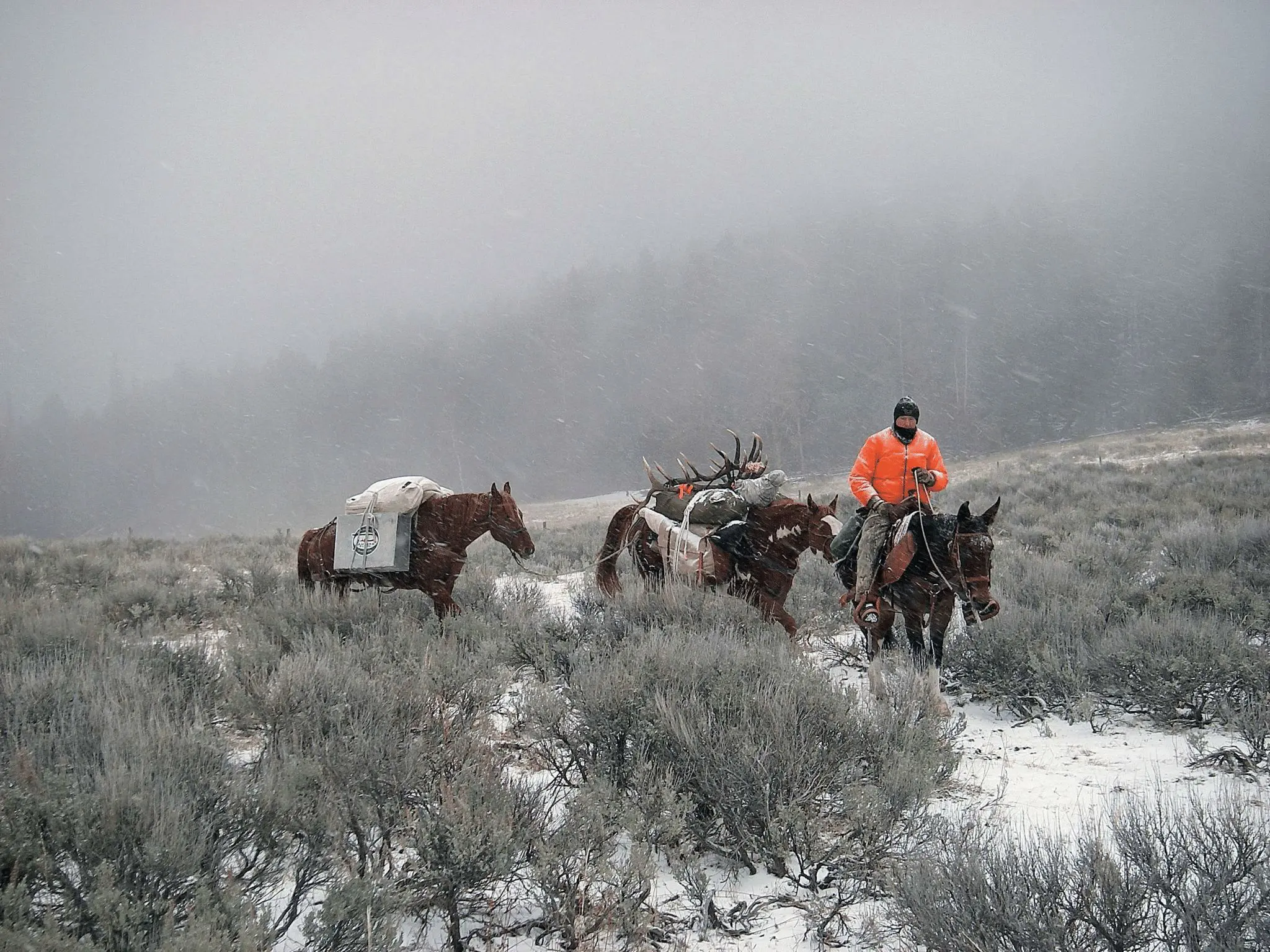
Light snow and moderate conditions generally do not have a significant impact upon keeping stock in backcountry camps or travelling in the backcountry. Camps are usually cozy with a variety of tents and wood stoves to keep hunters comfortable. The usual tack and gear used in moderate weather is generally adequate under these conditions. It is when snow is accompanied by cold weather, including warm spells when the ground thaws, gets slick and ultimately freezes that special attention needs to be paid to our stock and our gear. Negotiating a backcountry trail which may have been wet after a thaw or rain can be tricky after the temperature has dropped and water on the trail and in the ground turns into ice. Hillsides which have been saturated with water from rain or melting snow are especially treacherous, especially if they are covered with snow.
When riding your horse or mule while hunting or leading a pack string perhaps the most important consideration in late season weather conditions is whether the stock can handle the footing on the trail, mountain side or whatever terrain you may be negotiating. The feet of stock with or without shoes will collect snow which “balls up” under their feet. If the animal is barefoot the snow usually falls out periodically as the warmth of the hoof melts the bond between the snow and the hoof and because there is nothing to freeze to the snow ball is usually expelled from the hoof. Stock with regular steel shoes collect snow because snow melts from the warmth of the foot and refreezes to the steel shoe, causing hard-packed snowballs to form making it look as though the animal is standing on top of oranges or maybe grapefruits! Snowballs make it uncomfortable for the horse or mule to walk and puts the animal at risk for damaging slips and falls.
A horse adapts to cold short days through metabolism changes that slow the growth of the hoof wall. As a result, a simple remedy in the backcountry to snowball issues is to pull the shoes on your stock and trim their hooves ahead of the trip if you anticipate or know you travelling and hunting in snow. If you encounter snow at the trailhead or once you are in camp conditions may be such that you need to pull the shoes on your animals.
If you anticipate having your animals in snow you can prevent snowballs from forming by having your farrier put snowball pads under the shoes. There are generally three types of snowball pads. One is made of a flat plastic “plate” that is placed between the horse shoe and the foot and shaped accordingly. The second is a flexible rubber type pad that features a bubble in the middle of the pad pointing down which “pops” the snowball out of the hoof. The third type is the pad which I prefer and is called a “snow rim pad.” The rim pad is a perimeter pad that sits under your horse's shoe. A tube of plastic or rubber that may look like surgical tubing lies inside the shoe's inner edge and is designed so the rim will compress on impact and dislodge the snow.
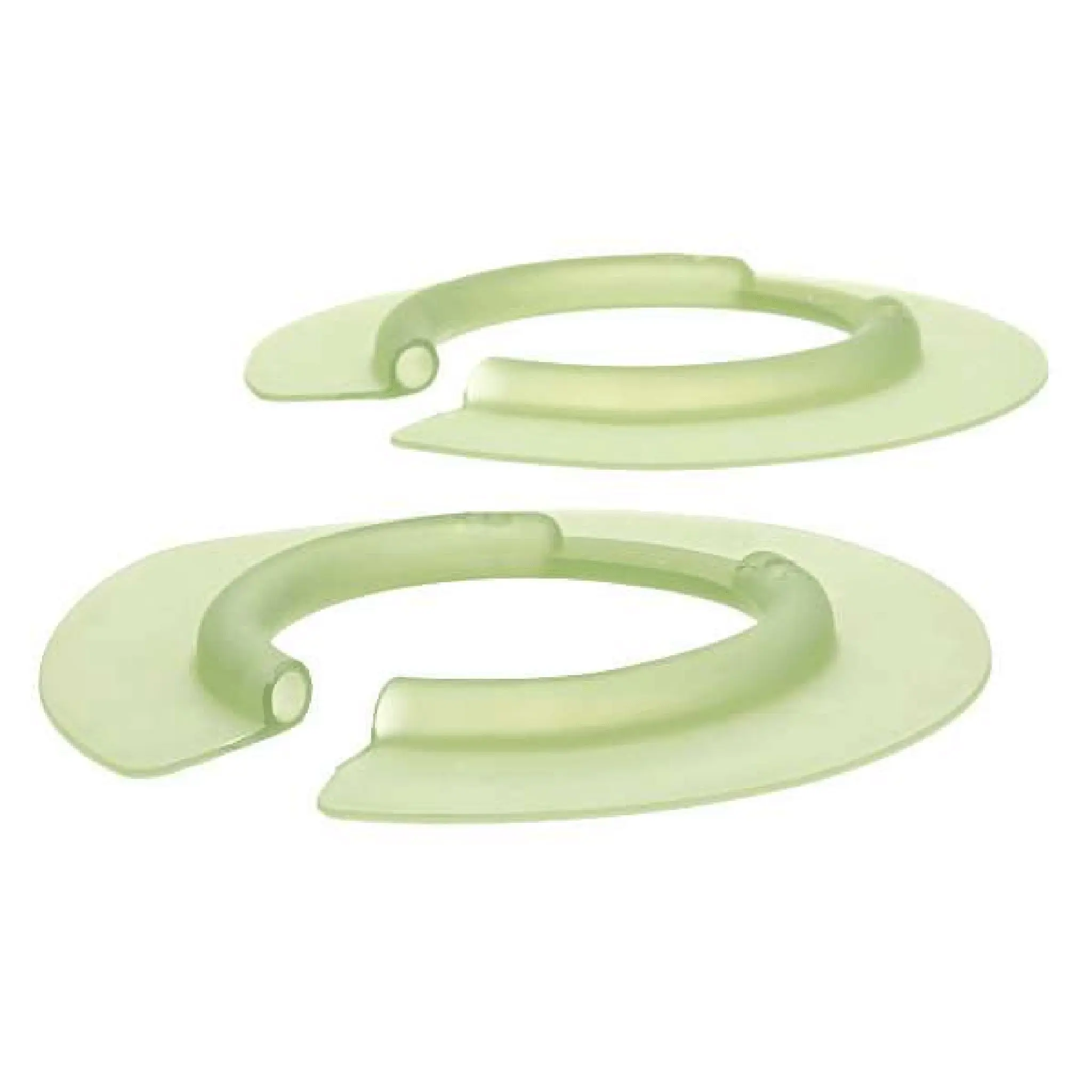
Snow rim pads such as the Mustad No Snow pads above are formed for front and rear feet. The portion of the pad that compresses looks like surgical tubing and functions to dislodge the snow.
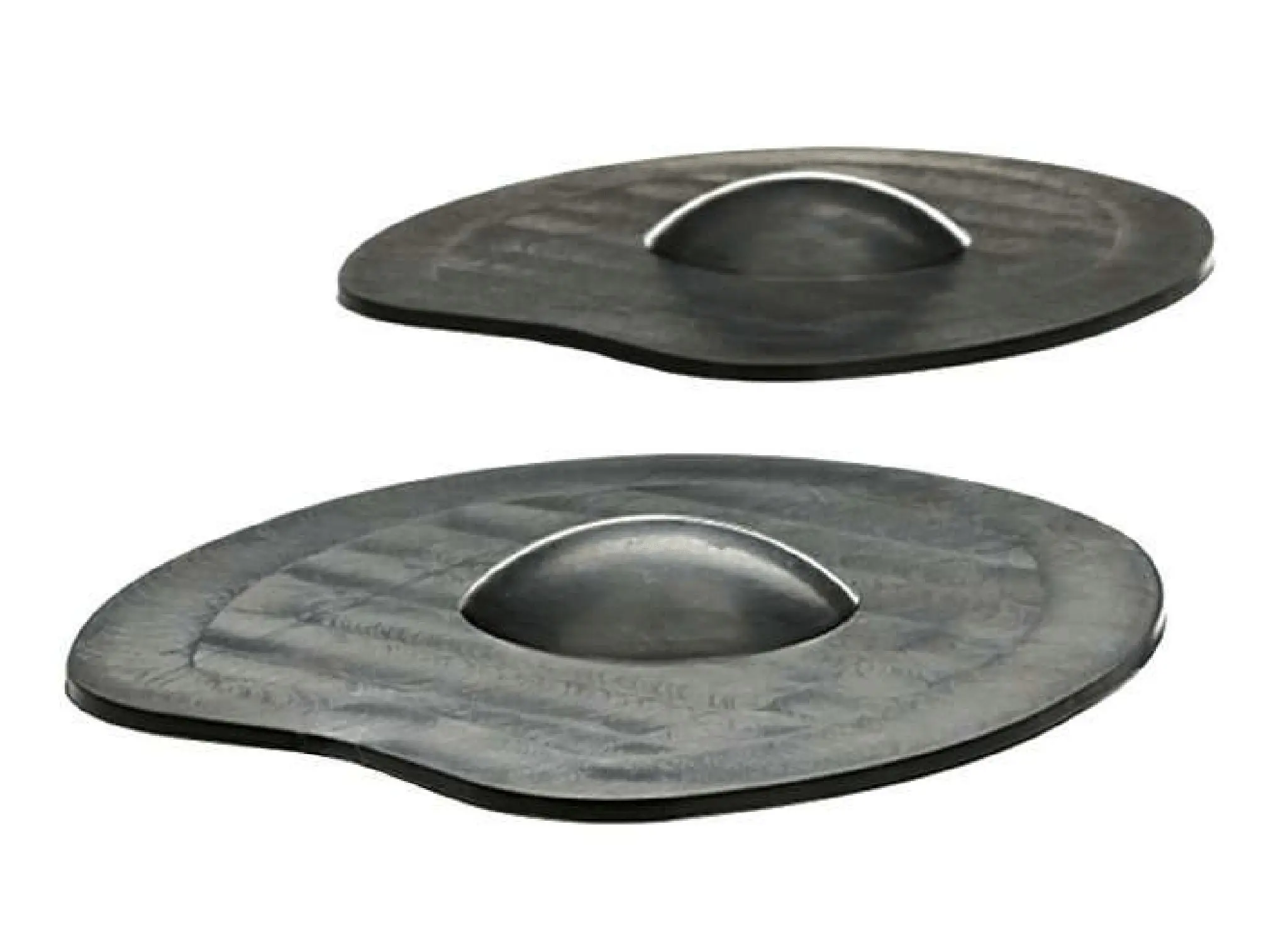
Snowball pads that cover the entire hoof include “popper” type pads which have a bubble that extends down and as your horse walks, the pad's domed center pops snow away from his hooves.
If you elect to use the snowball pad that covers the entire hoof you need to be alert of debris, moisture or bacteria that may become trapped beneath the pad. Some farriers apply the pad with silicon or another sealant to prevent these conditions. In some cases thrush may be caused by this type of snow pad.
Ice
Ice is especially dangerous and when hillsides, steep inclines or rocky trails are coated in ice. Both riding and pack animals can be seriously injured by a fall in the trail or one that results in the animal falling off the trail. Steep, rocky trails are especially hazardous areas. In situations like this proper shoe options that add traction are especially important.

A bare foot helps prevent snowballs from forming and keeps your horse's hoof directly on the ground. If the hoof is healthy, your stock may be very surefooted without shoes in snow, icy trails and mountain terrain. Running “barefoot” is the first level of addressing snow and ice conditions in the mountains and in most cases works very well.
When more severe conditions are encountered, especially where significant rock is combined with ice the slippery surface often requires animals to be shod with shoes that have traction devices applied. “Sharp shod” is the term often applied when stock have shoes with a added traction devices. Included among these traction devices are hard facing such as Borium/Drill Tech, drive-in/screw in calks and “frost nails.” In some cases clips are built into the front of the shoe to deal with the added forces created by the traction devices engaging the ground.
Hard facing shoes with Borium (tungsten) crystals that have been brazed onto the metal horseshoes have been the backcountry horsemen’s method of choice for years and have worked very well. It is applied to the shoe with a welder, usually after the shoe is shaped. Shoes with Borium applied can be purchased prior to shoeing and shaped like a normal shoe. Such shoes referred to as DuraSafe Borium Shoes can be ordered from The Blacksmith Shop in Dayton, VA. http://theblacksmithshop.net/
A similar traction application is called Drill Tek. Drill Tek is made up of coarse grit tungsten particles encased in a brass/silver solder matrix. It is brazed onto the shoe either by using an Oxy/Acetylene welding torch or in a gas forge and requires less heat than Borium. The Blacksmith Shop uses Drill Tek for hard facing on the shoes they sell.
Drive-in studs or pins come in various materials and shapes and offer variable amounts of traction according to the size of the calk head. They are constructed with a tungsten pin in the center of the stud. They are applied to the shoe prior to or after shaping by drilling specially created holes in the shoe and hammering the stud into the drilled hole. Drive in studs are designed to be left in place and have heads treated for extra traction. They are an excellent traction aid and do not require a welder or forge to install.
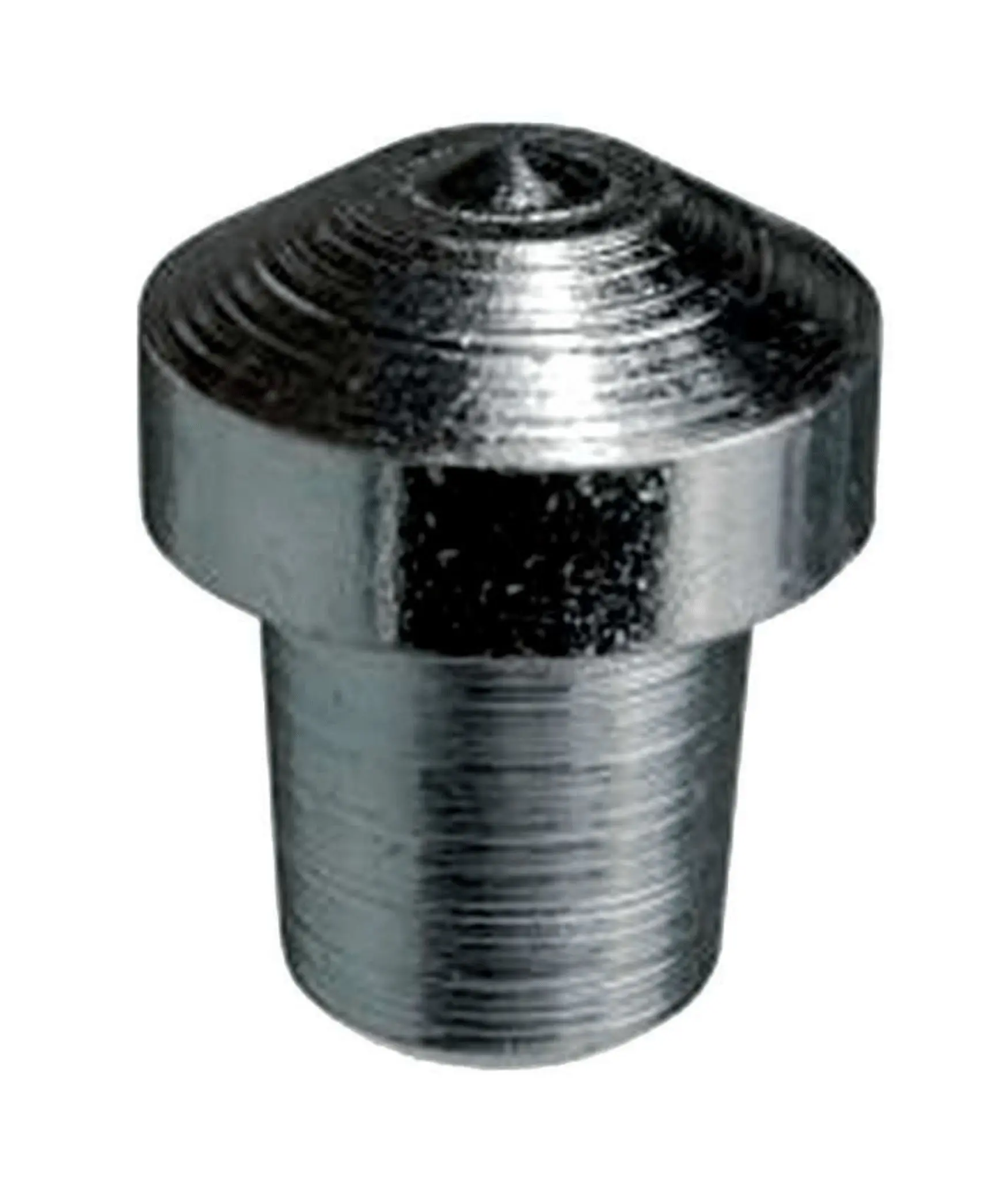
Mustad P-9 Drive-In Stud
Screw-in or "ice" calks are similar to drive-in calks, but they have a threaded base, making the calks removable. 3/8” screw-in studs which are top dressed Drill Tech Borium, called Durasafe screw in studs, may be obtained from the Blacksmith Shop. Once the horseshoe is drilled and tapped these studs can be screwed into the shoe or taken out as needed, making them an interesting option for hunters in changing late-season conditions.
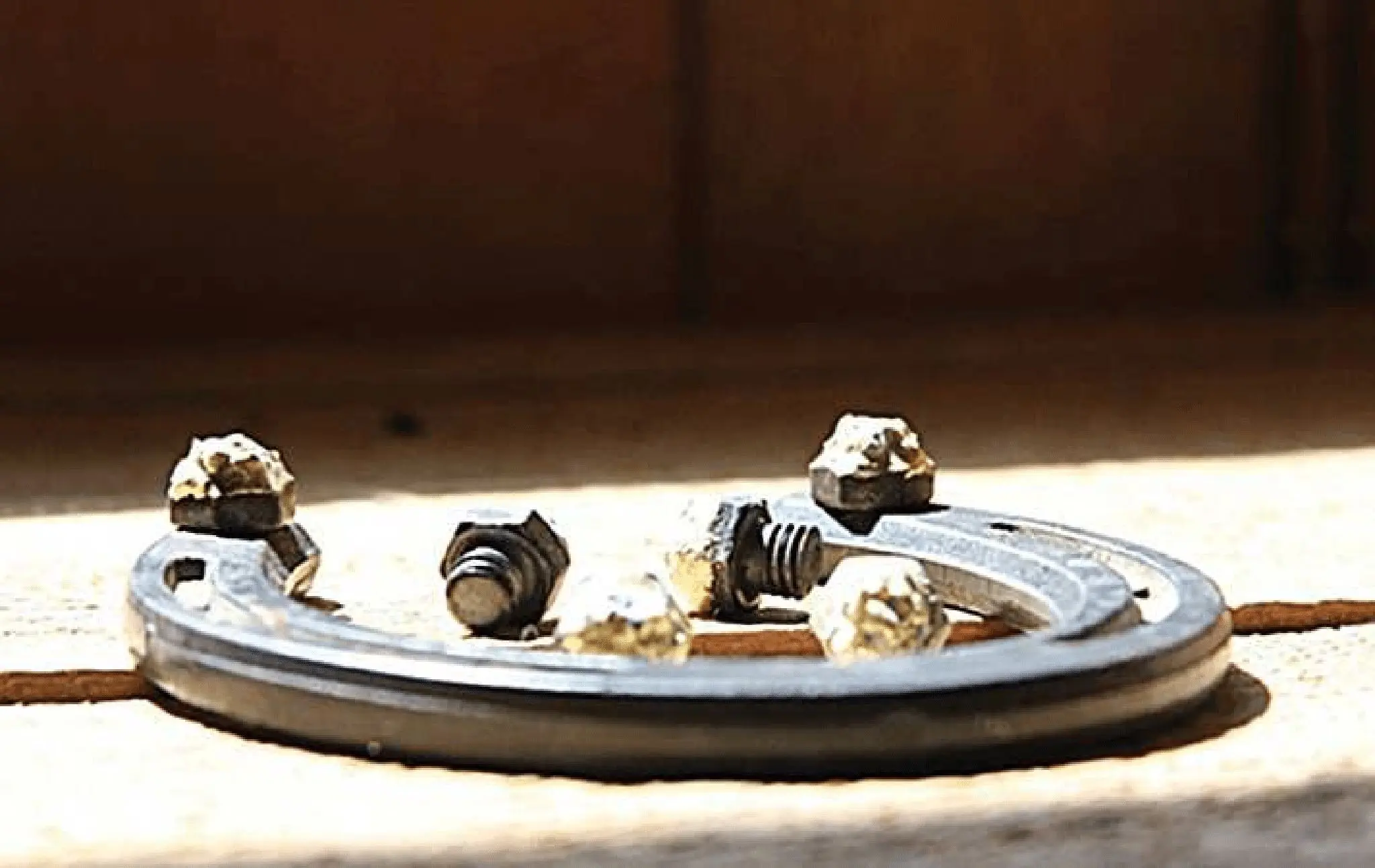
Durasafe screw-in studs with Drill Tech Borium. These 3/8” screw-in studs can be applied to the shoe or removed, making them an interesting option for late season hunters.
Ice or frost-rib nails have a normal square shape but are elongated and tapered. The normal head of the nail will be partially below the surface of the shoe when it is driven into the hoof wall. The protruding portion of the nail head will provide added traction for the horse or mule. Ice nails called Dura-Tec nails are topped by a drop of very hard tungsten or carbide steel. These nails are shaped similar to a normal nail but they extend slightly below the surface of the shoe similar to ice nails. Because of their hard surfacing Dura-Tec nails last longer than ice nails.
If you plan to use these traction devices on your stock you need to note that hard-facing material, studs and frost nails can damage your trailer mats….and I NEVER put these traction devices on animals that kick.
Shoeing stock with added traction devices on front feet only or all four feet is a common question that comes up when discussing the best options to consider. Shoeing front feet only is a very common choice, especially with mules. This method is preferred by many veteran packers and outfitters. The front feet are shod according to one’s preference and the hind feet have the benefits attributed to them being barefoot. In icy or slick conditions the front feet have the benefit of the traction devices (as well as snow pads) giving the horse or mule the stable footing attributable to the traction devices. With stable front footing barefoot rear feet compliment the front feet.
Wind
When we think of backcountry camps, wind is usually something that is pretty far down on the list of challenges we may anticipate encountering. Usually locating a camp that is in a sheltered area is sufficient to address any wind issues. However, there are many areas in the backcountry where one may have to locate a tent where there terrain and tree cover are not sufficient trees to provide a wind break. It is in these areas that wind can be a very destructive and significant factor. We are all familiar with upslope and downslope winds that occur daily in the mountains as surface temperatures change on a mountain slope. Winds that may not be as familiar to backcountry horsemen are called katabatic winds, downslope winds created when the mountain surface is colder than the surrounding air and creates a down slope wind that carries high-density air from a higher elevation down a slope under the force of gravity. I first experienced these winds in the Scapegoat Wilderness on the Rocky Mountain Front in the fall of 1990. We packed into a remote area after the wildfires of 1988 and had to camp in a creek bottom where the burned timber provided very limited shelter from the wind. It is a night I will never forget. You could hear the wind coming off the steep slopes high in the Scapegoat Wilderness. The trees would begin to move and creak as the wind speed picked up then as the wind gust approached it sounded like a freight train coming ever and ever closer. The sound was almost deafening as the wind hit our wall tent. The tent flapped so violently that the stove pipe was pulled out of the stove and it truly sounded like the train had arrived. Fortunately we had a sturdy wall tent made of 12 ounce cotton Vivitex material and we had constructed a sturdy lodge pole pine tent frame. The winds continued periodically much of the night and subsided by morning with no significant damage to the tent. Later I learned that these winds are called katabatic winds.
Since that time I have experienced a number of situations where katabatic winds have been an issue. Since it is difficult to predict when these wind events will occur, we have had three of these instances the winds destroyed tents which were not suitably designed or constructed to withstand such winds, even though we took measures to locate the camps as much out of the wind as possible. Wall tents are particularly vulnerable, especially the tents made with a cotton duck canvas roof and ReliteTM side walls. In my experience, the ReliteTM material gets stiff or “brittle” in very cold weather and high winds can literally rip out the seams. We have had two such tents in high winds on the Rocky Mountain Front and even though we sheltered them as much as possible, one was torn significantly and the aluminum frame was bent beyond repair, while the other tent literally ripped in half when the full force of the wind hit our camp.
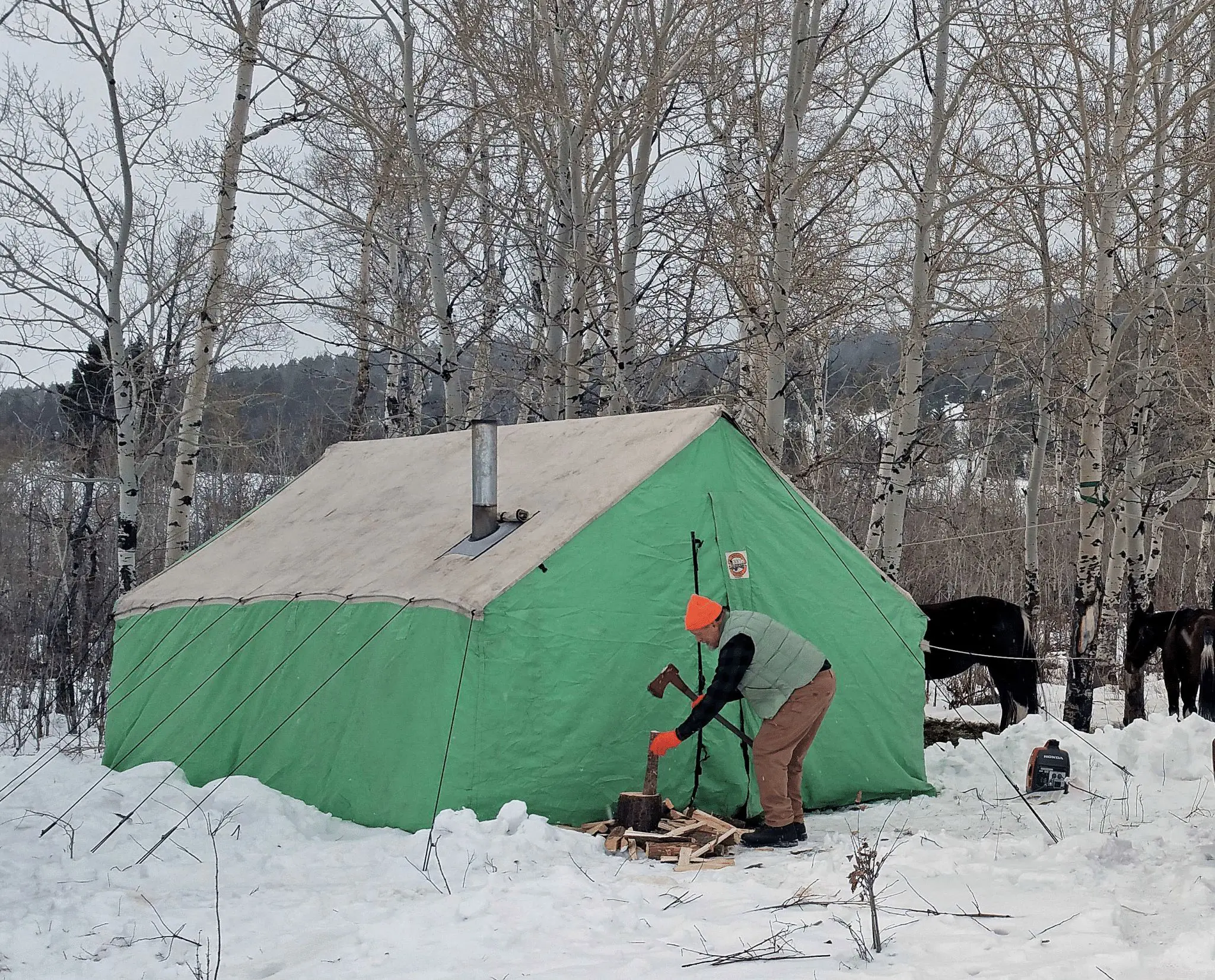
Tents which are constructed to withstand high wind conditions fare a lot better than wall tents in these situations. I have used the “Bombshelter” tent sold by Frontier Gear of Alaska as well as Arctic Oven tents made by Alaska Tent and Awning in similar high wind conditions all over the Western U.S., Montana as well as Alaska with excellent results. The tent fly and floor of the Arctic Oven tents are made of heavy-duty 4 oz. urethane coated oxford nylon (200-denier) and can be ordered with a heavy duty aluminum frame which adds a great deal of strength to the tent. I use an Arctic Oven 10’ Extreme tent with vestibule and find that it packs easily on my stock.
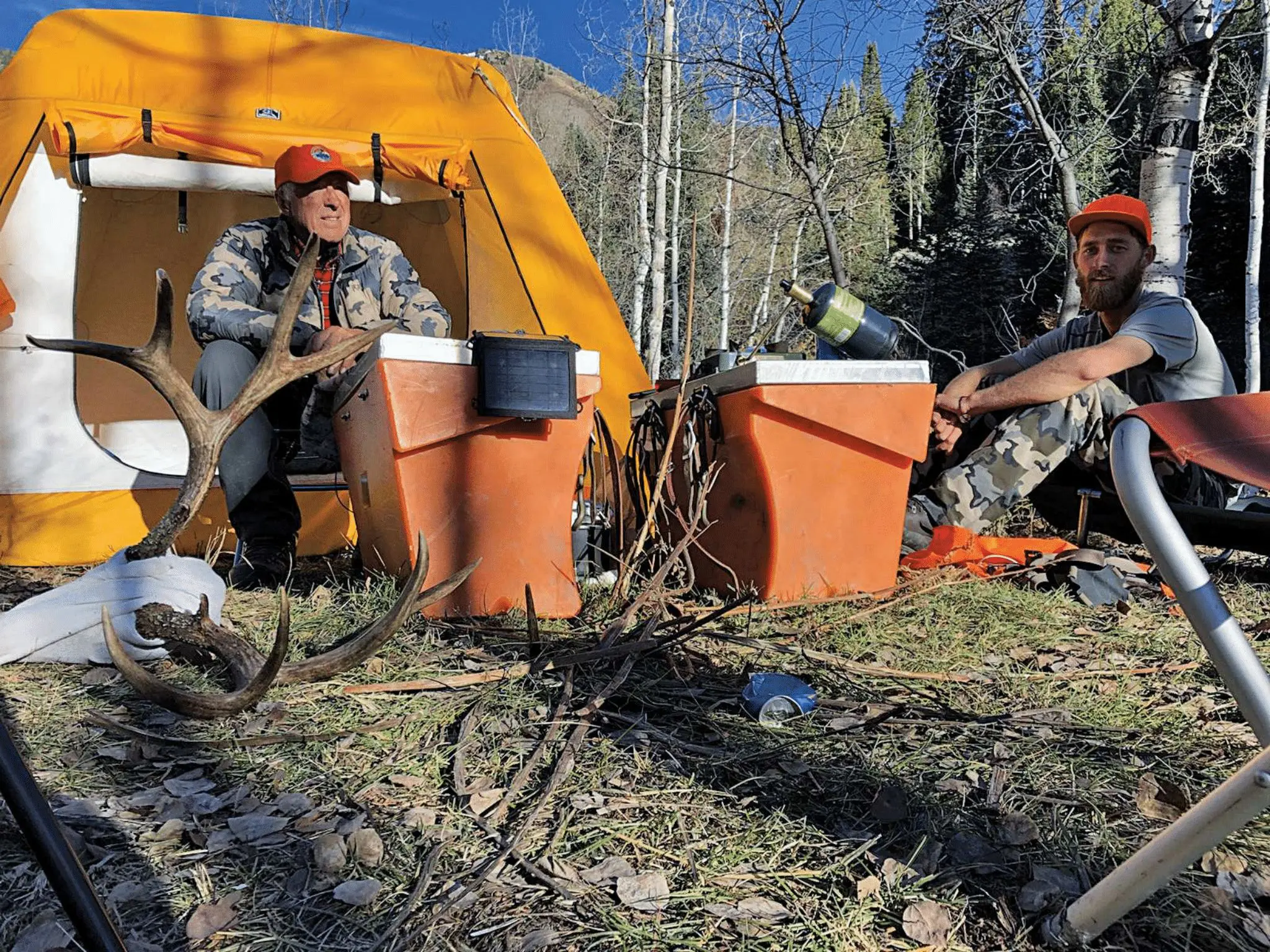
In these same, or similar situations we have had tents of other designs destroyed by high winds. In one instance I had a Cabela’s “M-1” tent rip apart and this fall we had a Cabela’s Ultimate Alaknak tent blown away by high winds in Montana. In regard to the Cabela’s tents, I must say that I have been extremely impresses with Cabela’s guarantee. In the case of the wall tents constructed of ReliteTM material, the one purchased through Cabela’s was replaced with a new tent. In the case of the M-1 tent, Cabela’s replaced it as well. This fall when wind destroyed my hunting partner’s Ultimate Alaknak tent Cabela’s replaced it as well. In today’s world, you simply can’t top Cabela’s high quality customer service!
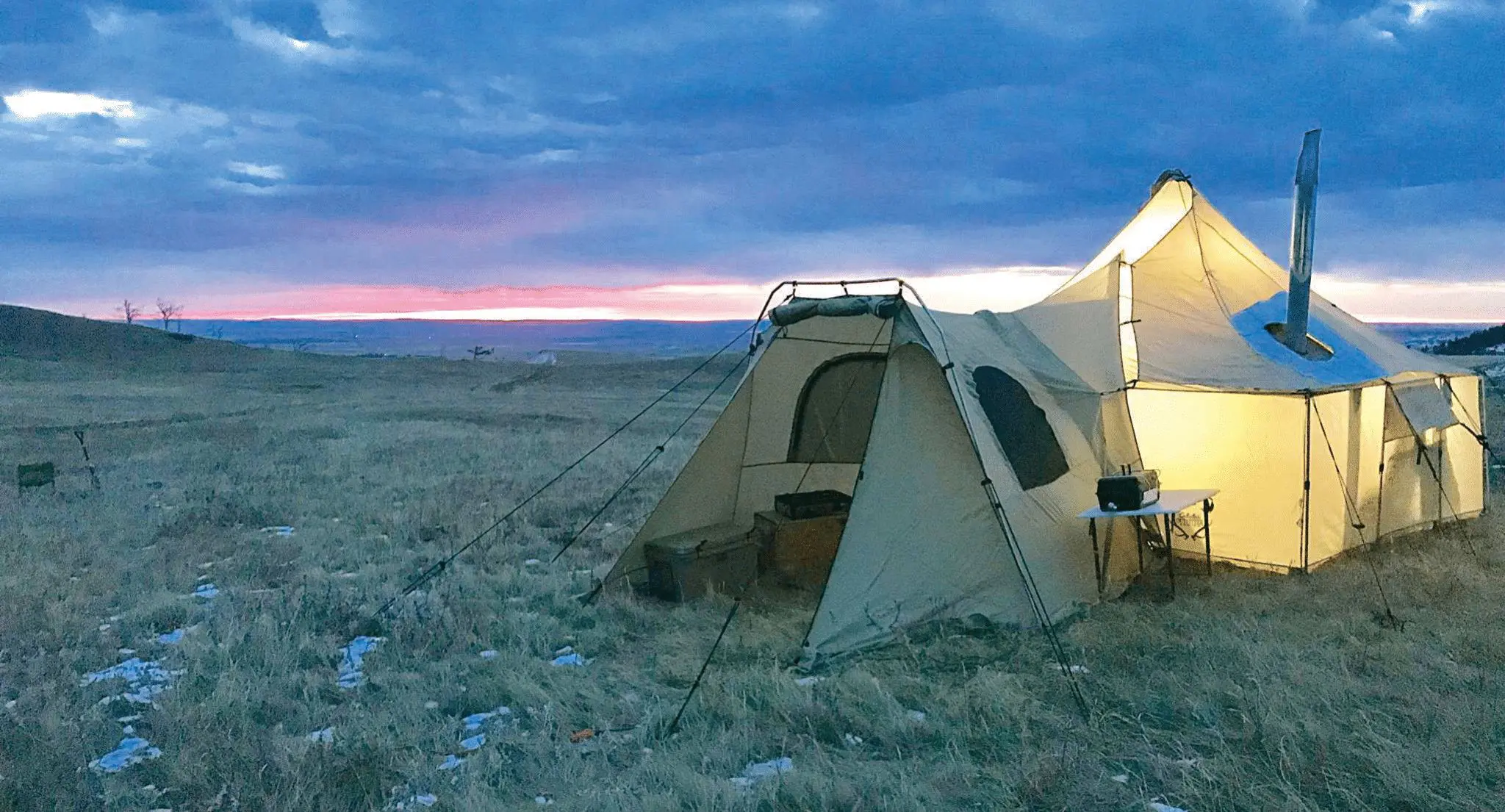
If you get the opportunity to make a late season hunt, come prepared, enjoy the backcountry, your stock and your hunting partners!

